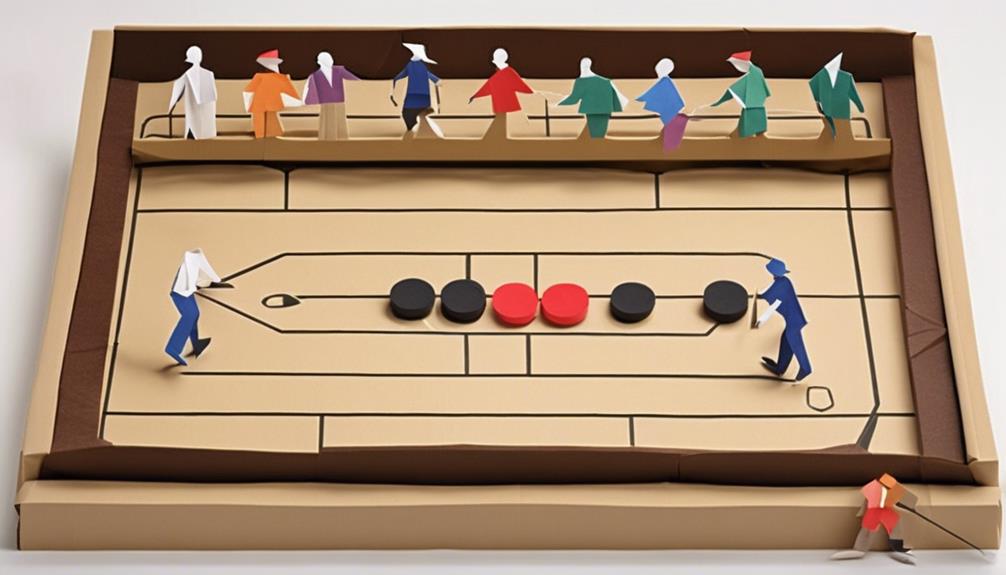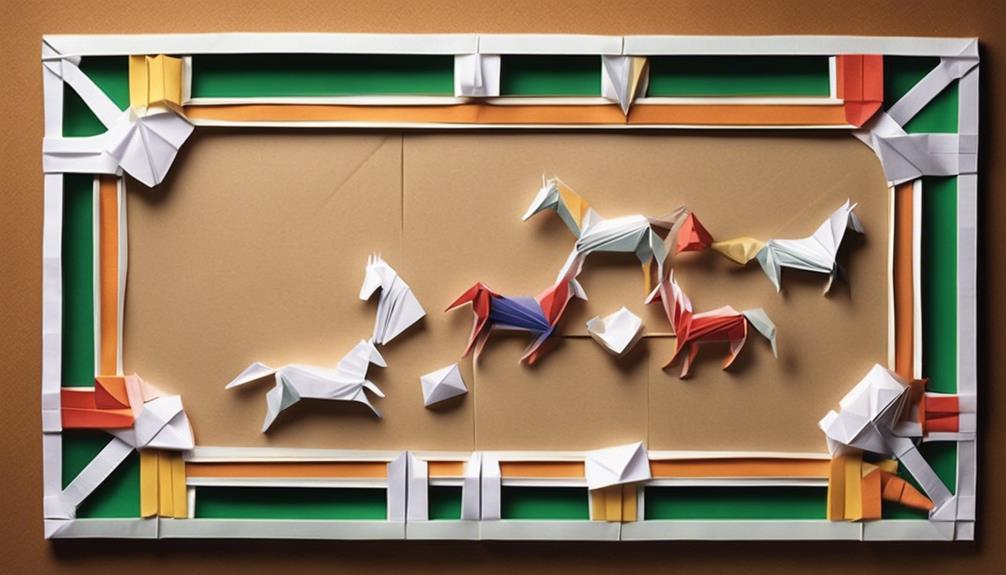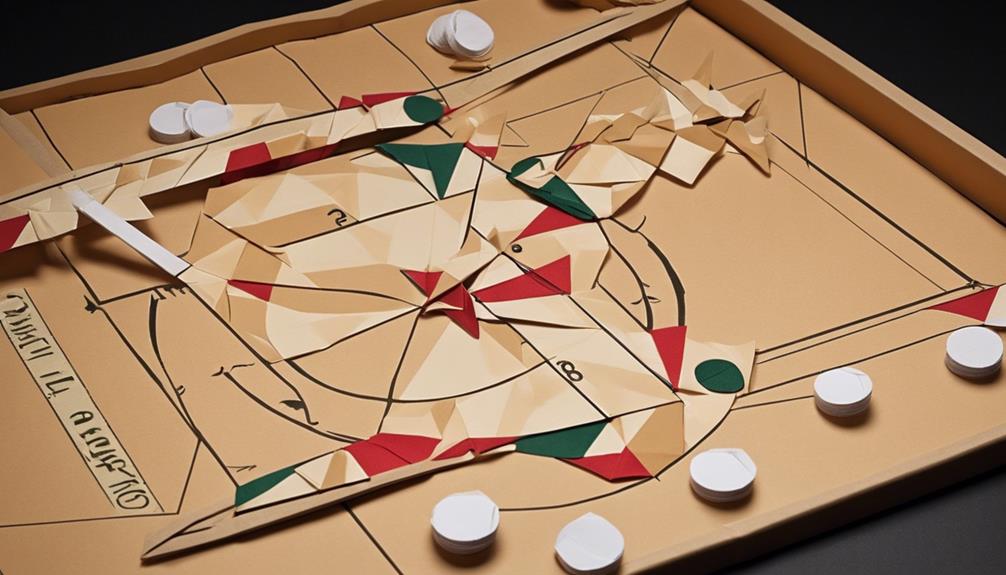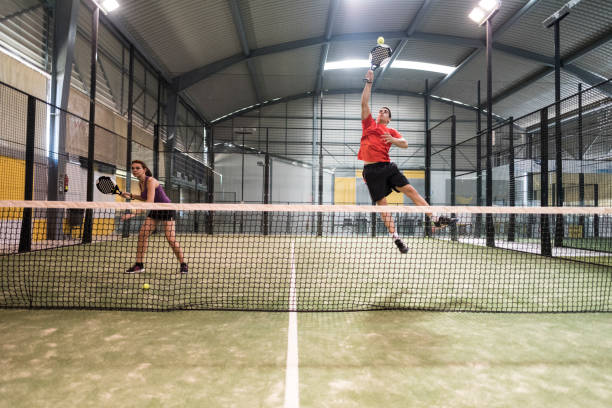General Rules of Shuffleboard Sport
You might think shuffleboard is a simple game, but once you start playing, you’ll realize there are specific rules and strategies that can elevate your gameplay. Understanding the equipment and court setup is just the beginning. As you progress through the rules of scoring, playing order, and tactics for blocking and knocking off opponents, you’ll uncover a more intricate side to this seemingly straightforward sport. Stay tuned to discover how mastering these nuances can truly enhance your shuffleboard experience.
Equipment and Court Setup

When setting up for a game of shuffleboard, ensure that the court is properly marked and the equipment is in place. Court maintenance is crucial for a fair and enjoyable game. Before starting, check that the court surface is clean and free of debris that could affect the movement of the discs. Make sure the lines on the court are clearly visible to avoid any disputes during the game. Regularly inspect the condition of the court to ensure it remains in top shape for every match.
In addition to court maintenance, caring for the equipment is essential. Keep the shuffleboard discs clean and free of any dirt or sticky residue that could alter their trajectory on the court. Store the discs in a cool, dry place to prevent warping or damage. Check the shuffleboard cues for any signs of wear and tear, replacing them if necessary to maintain consistency in your game.
When it comes to player attire and court decorum, comfort is key. Wear appropriate footwear that provides good traction on the court to avoid slips and falls. Remember to respect your opponents and maintain good sportsmanship throughout the game. Keep the area around the court tidy and free of any obstacles that could interfere with gameplay. By following these guidelines, you set the stage for a smooth and enjoyable shuffleboard experience.
Scoring System
To fully understand the game of shuffleboard, it is essential to grasp the intricacies of the scoring system used during play. When it comes to scoring in shuffleboard, there are key techniques and strategies that players can employ to maximize their points and outmaneuver their opponents.
- Scoring Techniques: Understanding the different ways to score points in shuffleboard, such as landing pucks in specific zones or knocking opponent’s pucks off the board, is crucial for success.
- Strategy Planning: Formulating a strategic approach based on the current game situation, your opponent’s moves, and the positioning of the pucks can give you a competitive edge.
In shuffleboard, point allocation is based on where your pucks land on the board and how close they are to the scoring area. The closer your puck is to the edge without falling off, the more points you will earn. Hence, precise target positioning is vital for securing high scores and frustrating your opponent’s attempts.
Playing Order

In shuffleboard, determining the playing order is typically decided through a coin toss or a designated rotation sequence among players. This player order is crucial as it can significantly impact the strategy rotation and the overall dynamics of the game. Once the playing order is established, the turn sequence follows this predetermined arrangement, ensuring fairness and equal opportunities for all players.
During a shuffleboard game, the player order remains consistent throughout the match unless a specific rule dictates otherwise. This creates a structured environment where each participant knows when it’s their turn to play and can plan their moves accordingly. The round rotation also follows a similar pattern, with players taking turns based on the established playing order.
Establishing a clear playing order helps in maintaining the flow of the game and allows players to strategize effectively. It adds an element of predictability while also offering opportunities for players to adapt their tactics based on the actions of their opponents. Understanding the player order and adhering to the turn sequence is essential for a fair and engaging shuffleboard experience.
Foul Shots
When it comes to foul shots in shuffleboard, it’s crucial to pay attention to your player positioning during the game. Understanding the penalty for illegal shots can help you avoid making mistakes that could cost you points. Keep in mind the rules and regulations to ensure fair play and maximize your chances of scoring in each round.
Player Positioning During Fouls
During a foul shot in shuffleboard, ensure that your position behind the designated line is maintained until the disc comes to a complete stop. It is important to follow this rule to avoid penalties and maintain fair play on the shuffleboard court. To ensure proper player positioning during fouls, consider the following:
- Maintain a steady stance behind the designated line.
- Refrain from crossing the line before the disc has stopped.
- Keep your movements minimal to avoid interference with the disc’s path.
- Wait for the disc to come to a complete stop before stepping forward.
Penalty for Illegal Shots
Upon committing an illegal shot in shuffleboard, players face consequences that impact the outcome of the game. Penalty enforcement in shuffleboard is crucial to maintain fair play. When a player makes an illegal shot, it can result in the removal of their disc from the scoring area or even a deduction of points from their score. Shot validation is typically done by the opposing player or team, ensuring that all moves adhere to the rules of the game. To prevent penalties, players must familiarize themselves with the regulations regarding legal shots and avoid any actions that could lead to penalties. By understanding and adhering to these rules, players can enjoy a more competitive and rewarding shuffleboard experience.
Blocking and Knocking Off

Now, it’s time to focus on the POINTS aspect of shuffleboard. As you aim to improve your game, understanding defense strategy basics, offensive play tactics, and key shot placements will be crucial. These elements will help you elevate your skills and outmaneuver your opponent on the shuffleboard court.
Defense Strategy Basics
When playing shuffleboard, understanding the defense strategy basics of blocking and knocking off is essential for success on the court. Defensive positioning is crucial in shuffleboard to prevent your opponent from scoring points easily. Here are some key points to consider:
- Maintain control of the scoring zones: By strategically placing your discs in the scoring area, you make it challenging for your opponent to score.
- Anticipate your opponent’s moves: Watch your opponent’s disc placements and plan your blocks accordingly.
- Focus on knocking off opponent’s discs: Use your shots to knock off your opponent’s discs from scoring positions.
- Strategic use of angles: Utilize angles to create barriers and make it difficult for your opponent to score.
Mastering these defense strategies will greatly improve your shuffleboard game.
Offensive Play Tactics
Understanding offensive play tactics in shuffleboard involves strategically employing blocking and knocking off techniques to gain an advantage over your opponent on the court. Offensive positioning is crucial in shuffleboard as it determines your ability to control the game and put pressure on your opponent. By strategically placing your discs to block your opponent’s scoring opportunities, you force them to adjust their shots, potentially leading to mistakes. Additionally, shot selection and execution play a significant role in offensive tactics. Choosing the right shots to either knock off your opponent’s discs or secure points for yourself requires precision and skill. Mastering these offensive tactics will give you the upper hand in shuffleboard, allowing you to dominate the game and secure victory.
Key Shot Placements
Mastering key shot placements in shuffleboard, including blocking and knocking off, is essential for gaining control and outmaneuvering your opponent on the court. When strategizing your moves, consider the following:
- Power shots: Utilize these to push your opponent’s discs off the scoring zones.
- Precision shots: Aim for accuracy to land your disc exactly where needed.
- Aggressive play: Use aggressive tactics to maintain dominance and pressure on your opponent.
- Defensive play: Employ defensive strategies to protect your own scoring discs while disrupting your opponent’s game.
Game Variations

Exploring various game variations in shuffleboard can add excitement and new challenges to your playing experience. Strategy variations and game modifications can bring a fresh twist to the traditional shuffleboard rules. One interesting variation is the “Knock Off” game, where players aim to knock their opponent’s weights off the board while keeping theirs on. This variation requires a different approach as players need to focus on both offense and defense simultaneously. Another exciting game modification is the “Speed Shuffleboard,” where players have a limited amount of time to make their shot, adding a sense of urgency and quick thinking to the game.
Rule exceptions and gameplay innovations can also spice up your shuffleboard matches. One such exception is the “Double-Off” rule, where a player can score double points by landing their weight in the 10-off section and knocking off their opponent’s weight in the process. This rule encourages risk-taking and strategic play. Additionally, innovations like the “Mystery Shot” add an element of unpredictability, where players must adapt their tactics on the spot based on the outcome of a mystery shot.
Match Duration
After exploring the various game variations that can enhance your shuffleboard experience, it’s essential to understand the significance of match duration in determining the pace and intensity of your games. Managing the time of your matches effectively can greatly impact your performance and overall enjoyment of the sport. Here are some key points to consider:
- Time Management: Keeping track of the time during a shuffleboard match is crucial to ensure that both players have a fair chance to compete. Setting time limits for each round or establishing a total match duration can help maintain a steady rhythm and prevent games from dragging on indefinitely.
- Break Strategies: Knowing when to take breaks during a match is essential for maintaining focus and avoiding burnout. Strategically timed breaks can help you regroup, refocus, and come back stronger, especially during longer or more intense games.
- Mental Endurance: Enduring through the ups and downs of a shuffleboard match requires mental strength and resilience. Building your mental endurance over time can help you stay sharp and composed even under pressure.
- Player Fatigue: Acknowledging the physical and mental fatigue that can set in during a match is crucial for preventing mistakes and maintaining a high level of play. Listening to your body and knowing when to rest or recharge is key to sustaining your performance throughout the game.
Strategy Tips

To elevate your game in shuffleboard, implementing effective strategy tips can give you a competitive edge and enhance your overall performance on the court. When it comes to shot selection, consider aiming for the sides of the scoring triangle as these areas offer more opportunities for scoring points. Positioning your discs strategically can also make it challenging for your opponent to score or block your shots. Placing your discs in a way that creates a barrier or limits your opponent’s options can be a smart move.
Engaging in mind games can also work to your advantage. Try to anticipate your opponent’s next move and adjust your strategy accordingly. By creating distractions or applying pressure through your gameplay, you may force your opponent into making mistakes. However, be mindful not to let distractions affect your own focus and gameplay.
Etiquette and Sportsmanship
When engaging in shuffleboard, it is essential to adhere to proper etiquette and demonstrate good sportsmanship throughout the game. Shuffleboard is not just about skill and strategy; it is also about how you conduct yourself on the court. Here are some key points to keep in mind:
- Fair Play: Always play by the rules and avoid any behavior that could be seen as cheating. Respect your opponents and the integrity of the game.
- Respect: Treat your fellow players with courtesy and kindness. Even in the heat of competition, remember to show respect for their abilities and efforts.
- Competition Dynamics: Understand that competition is a natural part of shuffleboard, but it should never overshadow the spirit of the game. Strive to win, but do so with grace and humility.
- Teamwork Dynamics: If you are playing in doubles or team games, remember that shuffleboard is a team sport. Support your partner, communicate effectively, and celebrate both individual and team successes.
Frequently Asked Questions
Can Players Use Their Own Personal Shuffleboard Cues or Are They Required to Use Equipment Provided by the Facility?
You can typically use your own shuffleboard cues, but it’s wise to check with the facility. Some places may have rules about equipment. It’s cool to bring your gear, just be sure to follow any guidelines they have.
Are There Any Specific Rules Regarding Player Attire or Dress Code During Shuffleboard Matches?
When you step onto the shuffleboard court, your attire should reflect the player etiquette expected in competitions. Dress comfortably, but be aware of attire restrictions that may apply to ensure fair play.
Is There a Maximum Number of Players Allowed on a Shuffleboard Team, or Can Teams Be Made up of Any Number of Players?
When forming a shuffleboard team, the number of players can vary, offering flexibility in strategy. Different team sizes influence competitive advantage and dynamics during matches. Consider your group’s strengths and dynamics to optimize performance.
Are There Any Restrictions on Where Players Can Stand or Move During a Shuffleboard Match?
In shuffleboard, players must navigate the court boundaries strategically. Proper positioning and etiquette are key. Remember, where you stand impacts your game. Adhering to these guidelines will enhance your shuffleboard experience.
Are There Any Specific Rules or Guidelines for Spectators Watching a Shuffleboard Match?
When watching a shuffleboard match, remember spectator etiquette. Respect players’ focus and avoid distracting movements. Find suitable viewing positions that don’t interfere with the game. Stay engaged, but maintain a respectful distance for an enjoyable experience.






